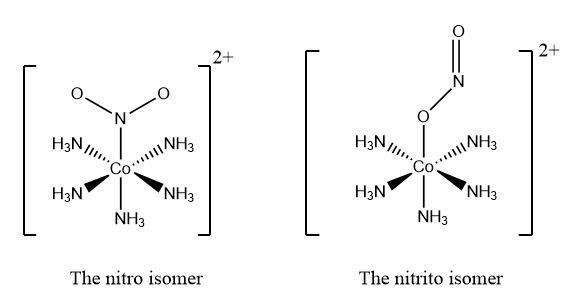
$\left[ Co{{\left( N{{H}_{3}} \right)}_{5}}N{{O}_{2}} \right]C{{l}_{2}}$ and $\left[ Co{{\left( N{{H}_{3}} \right)}_{5}}\left( ONO \right) \right]C{{l}_{2}}$ are related to each other as:
A) Geometrical isomers
B) Optical isomers
C) Linkage isomers
D) Coordination isomers
Answer
219.3k+ views
Hint: In some coordination complexes, isomerism is observed when a ligand is bonded to the central atom through two or more than two atoms of the same ligand. Some ligands (like $N{{O}_{2}}$) consist of more than one atom which can act as the donor atom and can donate the electron pair to the central metal atom.
Complete answer:Linkage isomers: The coordination compounds which consist of the same composition of the ligands but the central metal ion is connected to different atoms of the same ligand. Those coordination compounds are known as Linkage isomers. As the bonding atom is different in both complexes, it is categorized under Structural isomerism.
For example Thiocyanate group i.e., $SC{{N}^{-}}$ can be bonded to the central metal atom through sulphur as well as nitrogen due to the availability of the lone pair of electrons on both atoms.
Some of the ligands that bond with central metal ions to show linkage isomerism are as follows:
1. Thiocyanate ($SC{{N}^{-}}$) in which the central metal ion is bonded to sulphur atom and Isothiocyanate ($NC{{S}^{-}}$) in which the central metal ion is bonded to the nitrogen atom.
2. Nitrite group can be bonded in two ways as $NO_{2}^{-}$ and $ON{{O}^{-}}$
In the given question, the complex given are $\left[ Co{{\left( N{{H}_{3}} \right)}_{5}}N{{O}_{2}} \right]C{{l}_{2}}$ and $\left[ Co{{\left( N{{H}_{3}} \right)}_{5}}\left( ONO \right) \right]C{{l}_{2}}$which can be structurally represented as follows:

When the nitrogen atom is bonded to the central metal ion, then the complex is named as a nitro complex whereas when the oxygen atom donates its lone pair of electrons to cobalt, then the complex is named as nitrito complex.
Hence, the given complexes are related to each other by linkage isomerism. Therefore, option (C) i.e., linkage isomerism is the correct answer.
Note: It is important to note that in the linkage isomerism, the formula and composition of the complex remain the same but the properties of the complex differ from each other. Also, a change in the name of denoting the ligand is also observed (nitro and nitrito).
Complete answer:Linkage isomers: The coordination compounds which consist of the same composition of the ligands but the central metal ion is connected to different atoms of the same ligand. Those coordination compounds are known as Linkage isomers. As the bonding atom is different in both complexes, it is categorized under Structural isomerism.
For example Thiocyanate group i.e., $SC{{N}^{-}}$ can be bonded to the central metal atom through sulphur as well as nitrogen due to the availability of the lone pair of electrons on both atoms.
Some of the ligands that bond with central metal ions to show linkage isomerism are as follows:
1. Thiocyanate ($SC{{N}^{-}}$) in which the central metal ion is bonded to sulphur atom and Isothiocyanate ($NC{{S}^{-}}$) in which the central metal ion is bonded to the nitrogen atom.
2. Nitrite group can be bonded in two ways as $NO_{2}^{-}$ and $ON{{O}^{-}}$
In the given question, the complex given are $\left[ Co{{\left( N{{H}_{3}} \right)}_{5}}N{{O}_{2}} \right]C{{l}_{2}}$ and $\left[ Co{{\left( N{{H}_{3}} \right)}_{5}}\left( ONO \right) \right]C{{l}_{2}}$which can be structurally represented as follows:

When the nitrogen atom is bonded to the central metal ion, then the complex is named as a nitro complex whereas when the oxygen atom donates its lone pair of electrons to cobalt, then the complex is named as nitrito complex.
Hence, the given complexes are related to each other by linkage isomerism. Therefore, option (C) i.e., linkage isomerism is the correct answer.
Note: It is important to note that in the linkage isomerism, the formula and composition of the complex remain the same but the properties of the complex differ from each other. Also, a change in the name of denoting the ligand is also observed (nitro and nitrito).
Recently Updated Pages
Is PPh3 a strong ligand class 12 chemistry JEE_Main

Full name of DDT is A 111trichloro22bispchlorophenyl class 12 chemistry JEE_Main

Sodium acetate on heating with soda lime produce A class 12 chemistry JEE_Main

Find the isoelectric point pI of Lysine A 556 B 974 class 12 chemistry JEE_Main

The order of basicity among the following compounds class 12 chemistry JEE_Main

The number of isomers in C4H10O are a7 b8 c6 d5 class 12 chemistry JEE_Main

Trending doubts
JEE Main 2026: Application Form Open, Exam Dates, Syllabus, Eligibility & Question Papers

Derivation of Equation of Trajectory Explained for Students

Hybridisation in Chemistry – Concept, Types & Applications

Understanding the Angle of Deviation in a Prism

Understanding Collisions: Types and Examples for Students

Understanding Atomic Structure for Beginners

Other Pages
NCERT Solutions For Class 12 Chemistry Chapter 1 Solutions - 2025-26

NCERT Solutions for Class 12 Chemistry Chapter Chapter 7 Alcohol Phenol and Ether

NCERT Solutions ForClass 12 Chemistry Chapter Chapter 8 Aldehydes Ketones And Carboxylic Acids

JEE Advanced Marks vs Ranks 2025: Understanding Category-wise Qualifying Marks and Previous Year Cut-offs

Haloalkanes and Haloarenes Class 12 Chemistry Chapter 6 CBSE Notes - 2025-26

Solutions Class 12 Chemistry Chapter 1 CBSE Notes - 2025-26




